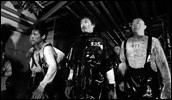Kanikosen
- Year
- 2009
- Original title
- Kanikosen
- Japanese title
- 蟹工船
- Alternative title
- The Crab Cannery Ship
- Director
- Cast
- Running time
- 109 minutes
- Published
- 22 December 2009



by M. Downing Roberts
Adapted for the screen from Takiji Kobayashi's 1929 classic of proletarian literature, Kanikosen is the story of a workers' strike aboard a cannery ship on the northern Sea of Japan. For Takiji, it was a representative portrait of exploitation, one that sought to concretize the situation of nearly 80% of the labor in early Showa Japan.
In 2008, Kanikosen awoke from decades of canonical slumber, to become an unexpected best-seller, with Japanese sales rocketing from a long-standing average of 5,000, to over 500,000 copies in a single year, not including figures for its four different manga adaptations. As critics scrambled to understand how an eighty-year-old proletarian novel could suddenly speak to the depoliticized younger generations, the Kanikosen boom began to appear like a swooning canary in the coal mine of post-bubble capitalism.
With the boom peaking, Sabu was tapped to direct a new film version that could catch the wave of enthusiasm. Previously, Kanikosen had been adapted in 1953 by So Yamamura, and it is at times instructive to compare these two very distinct renderings of Kobayashi's novel. For, a new screen adaptation raises some immediate questions: can this fictional drama of prewar political struggle transcend both the wartime and postwar experience, to illuminate the lived conflicts of contemporary Japan? If so, how exactly?
Sabu's Kanikosen begins with an emblematic set piece: a lone worker on the cannery ship peers out of the hold. Frozen in fear of the unknown and unable to move, he is crushed under a giant net of crabs. This gruesome twist on the relation between worker and product recalls the sardonic dictum: "Every single commodity you produce is a piece of your own death." Straightaway, Sabu introduces the production process, with exhausted laborers toiling aboard the factory ship, its outsized machinery serving as an abstraction for industrial capital. The laborers are kept in line by Asakawa (Nishijima), the oppressive company foreman who exhorts them to work for the nation, to build Japanese power via the international market. When the factory ship's radio receives an S.O.S. from another vessel, Asakawa refuses to suspend operations for a rescue, brutally overriding the captain's authority.
Sabu's first order of business, then, is to show the inhumanity of capital and its symbiosis with the ideology of the Imperial state. Rather than depicting this in an unhurried realist mode, as Yamamura did in the 1950s, or in the fashion of a standard period drama, Sabu opts for a compressed, theatrical style. With little in the way of historical detail and much idiosyncratic artifice (e.g., the contemporary hairstyles, horror-film interiors, or an overseer shouting through an electronic megaphone), Sabu makes a deliberate bid to bring the conflict closer to a contemporary audience. This means, though, that his film also operates on a more conceptual plane.
If at first Sabu presents his workers as a depersonalized mass, soon they become a group, their stories illustrated with brief flashbacks to scenes in rural Japan. One of the most salient features of Kobayashi's novel is its rendering of a "collective hero". Its working-class protagonists are neither probed for character or psychology, nor even given proper names. While Asakawa is identified by name, he too functions more as the representative of a class rather than an individual interest. Yamamura adapted this technique for the screen, giving a broad, cinematic illustration of a lighthearted working-class milieu, but without linearizing the narrative around specific characters. Sabu breaks with this approach, for from this nameless group, Shinjo (Matsuda) is particularized first as a character, and then as the workers' delirious leader.
While Sabu spares little in rendering the company's violence against the workers, the catalyst for their rebellion is located elsewhere, far from the cruelties of the production line. Lost at sea on a small trawler, Shinjo and a co-worker are recovered by a Russian ship. Fearing the Red menace painted by the Japanese propagandists, they instead find a scene defying all preconceptions about Soviet life, and learn to hope for their own liberation. Returning to the factory ship, this newfound resolve carries them forward to organize a strike.
Where Yamamura begins with milieu, Sabu begins with toil. Yet, he is quick to undercut any sense of miserablism with touches of comedy. Indeed, humor and incongruity are significant elements in his treatment of Kanikosen. When the workers tell their stories, we are meant to chortle at their pitiful families, not feel any direct empathy, and in moments of angish, their emotion is often suddenly heightened into the register of pastiche. Nor is poverty singled out, as the foppish Kimura brothers evoked by Shinjo are shown to be equally risible. Here, Sabu's approach is more Brechtian, interrupting flows of raw sentiment with appeals to our colder powers of judgment.
Such a thoroughgoing anti-realist approach involves certain trade-offs. By focusing the conflict through abstracted, ahistorical characters, a more elaborated view of the social structure is sacrificed. In Yamamura's realist mode, by contrast, the class structure and division of labor - workers, foreman, CFO, capitalist, doctor, etc. - can be shown vividly. We see this even in an incidental scene of the workers on break, enjoying a silent American Western with benshi narration, against which Yamamura juxtaposes shots of the bosses drinking expensive liqueur while listening to phonograph music. The characterization of Asakawa offers another point of comparison. At the outset, Yamamura depicts him as a harried worker in the direct employ of capital. We are shown the company representatives who pressure him, and his subsequent transformation from a seemingly moderate manager into a barbaric tyrant. By eliminating this context, Sabu's version of Asakawa becomes a static image of pure violence. Clad in a long white coat stained with blood, his appearence is both dazzling and grotesque - the son of a military aristocrat melded with a hunky butcher.
While Sabu zealously renders the brutality of the factory ship, this dimension of Kobayashi's novel seems in fact to be of indirect importance in its present revival. Insofar as such abusive forms of exploitation largely belong to an earlier period in Japanese history, the contemporary resonance of the novel lies rather in the image of the factory ship as a floating metaphor, one that crystallizes the precarity, malaise, and growing inequality of present-day Japan. Further, Kobayashi's story offers clear values - class consciousness and solidarity - that reverberate beyond the present impasse, to return a sense of hope that the bad days can, and will, end.
The treatment of solidarity is perhaps Sabu's most significant departure from Kobayashi. An image of joined hands is foregrounded as the emblem of the film, but in a curious reversal, several key scenes subordinate the value of collective action to an emphasis on individual responsibility. This is overt in the choice to foreground Shinjo as a leader, and in the sequence depicting his encounter with the Russians. In the original story, this episode functioned as an antidote to the distortions of Imperialist propaganda, and a lesson in the power of solidarity. The Russians are confident that their Japanese visitors, too, can return home and unite against their class enemy: "Nothing to worry about. You will win. Understand?" Sabu wisely includes this episode (Yamamura did not), but dramatically shifts its message. When the problem of political engagement surfaces above the ambient flippancy of a goofy Chinese interpreter, dancing girls, and visual gags, it is couched in terms of individual choice and responsibility. For Sabu's characters, the insight is not that collective action is the single, sure means to change the status quo, but simply that individuals have the power and obligation to act.
Ultimately, the task of adapting Kanikosen for a contemporary audience poses a dilemma. By focusing on individuals, a character-driven approach makes the broader socio-political conflict more immediately legible. The use of theatrical distancing effects steers clear of trite sentiment, while focusing the conflict and bringing it closer to us in historical time. Yet, this approach tends to pose the underlying problem as one of individual decision, apathy or engagement. These may be the appropriate forms of appeal to reach a contemporary audience, but they also work to obscure one of Kobyashi's fundamental insights.
For the true battle isn't against the Asakawas of this world, but against the social structure that produces them, against a larger nexus of capital, state, and military (in part, what we would today call the military-industrial complex). For Kobayashi, one of the primary aims of his literary art was to convey a more profound understanding of this social structure - not the what, but the why of it - beyond mystifications such as "the nation" or "the people". What Sabu's adaptation of Kanikosen implicitly asks us to think about, then, is the manner and mode in which a film about political conflict can speak to a depoliticized audience, and the role it plays in expanding our sense of "the art of the possible".